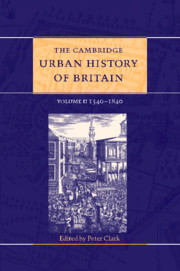Book contents
- Frontmatter
- 1 Introduction
- Part I Area surveys 1540–1840
- Part II Urban themes and types 1540–1700
- Part III Urban themes and types 1700–1840
- 14 Urban growth and economic change: from the late seventeenth century to 1841
- 15 Population and society 1700–1840
- 16 Politics and government 1700–1840
- 17 Culture and leisure 1700–1840
- 18 The transformation of urban space 1700–1840
- 19 London 1700–1840
- 20 Regional and county centres 1700–1840
- 21 Ports 1700–1840
- 22 Small towns 1700–1840
- 23 Health and leisure resorts 1700–1840
- 24 Industrialising towns 1700–1840
- 25 Conclusion
- Select Bibliography
- Index
- References
15 - Population and society 1700–1840
from Part III - Urban themes and types 1700–1840
Published online by Cambridge University Press: 28 March 2008
- Frontmatter
- 1 Introduction
- Part I Area surveys 1540–1840
- Part II Urban themes and types 1540–1700
- Part III Urban themes and types 1700–1840
- 14 Urban growth and economic change: from the late seventeenth century to 1841
- 15 Population and society 1700–1840
- 16 Politics and government 1700–1840
- 17 Culture and leisure 1700–1840
- 18 The transformation of urban space 1700–1840
- 19 London 1700–1840
- 20 Regional and county centres 1700–1840
- 21 Ports 1700–1840
- 22 Small towns 1700–1840
- 23 Health and leisure resorts 1700–1840
- 24 Industrialising towns 1700–1840
- 25 Conclusion
- Select Bibliography
- Index
- References
Summary
this chapter aims to provide an overview of the process of demographic change in the burgeoning growth of towns and cities of the period 1700–1840. The first section will consider the characteristics of migration into urban areas. English towns in this period had a preponderance of females. Why was this the case? What is the particular role of women in the process of urbanisation? The second section will examine the ‘vital events’ of marriage, birth and death. Notably, this time period has been dubbed ‘the dark ages’ of urban demography. The label is justified not only because there are large gaps in our knowledge, but also as a result of the fact that this period is characterised by excess mortality associated with desperate living conditions. The chapter develops by exploring the effects of population change on the progress of urban society. How did migrants assimilate into urban life? How did urbanisation affect social structures? The 1851 census showed that by the mid-nineteenth century half of the population of England and Wales lived in towns. How did people shape the urban context?
THE CHARACTERISTICS OF MIGRATION
There is no doubt that urban growth on the scale described by John Langton in the last chapter was to a large measure a result of migration. Yet there has been no detailed analysis of migration into towns and cities for this time period. The paucity of research is particularly apparent for 1750–1850, in which urbanisation and industrialisation are related processes. Indeed much of the available evidence is impressionistic and based on biographical and genealogical material which is only just starting to be quantified.
- Type
- Chapter
- Information
- The Cambridge Urban History of Britain , pp. 491 - 528Publisher: Cambridge University PressPrint publication year: 2000
References
- 6
- Cited by

